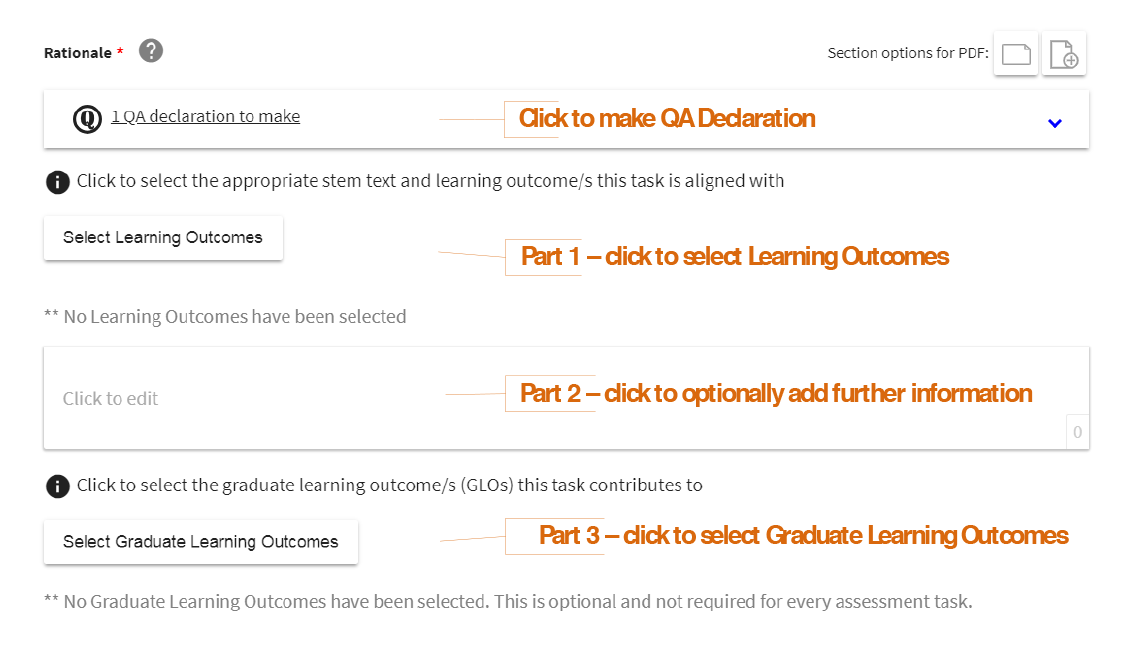Rationale
There are three (3) parts to the Rationale section within Assessment and Exam Items; plus a QA Declaration. Learn more: Rationale Sub-Sections

Part 1 Mandatory - select Subject Learning Outcomes
The rationale is where you have the opportunity to show the links between the assessment task and the Learning Outcomes; and describe the purpose of the task. The selection of Learning Outcome/s in Part 1 makes this explicit. The selected Learning Outcomes are then used as a base to develop your criteria.
Click the Select Learning Outcomes button to open a pop up where the appropriate stem text and Learning Outcomes can be selected.
Stem text is the statement that will precede the selected Learning Outcomes. Select the appropriate stem text from three (3) options. Options state that the selected the Learning Outcome/s are either assessed by the task; or the task works towards them —OR— states that the task is a ‘hurdle’ that does not directly assess a specific learning outcome but is a requirement for passing the subject.
The Compliance Check upholds the following logic:
- Each Assessment/Exam Item must be mapped to at least one (1) Learning Outcome UNLESS the hurdle stem text is selected; and
- All LOs must be mapped to at least one (1) Assessment/Exam Item, i.e. all LOs must be assessed
Learn more:
Selecting Subject Learning Outcomes
Compliance Check - Learning Outcomes
Part 2 Optional - further explain the rationale
You can opt to use the editor to further explain the rationale, i.e. Part 2 can be left null of the Learning Outcomes mappings sufficiently explain the rationale. If left null, this section will not display in the final version of the Outline.
As appropriate, further explain the purpose of the task, identify the skills and knowledge students will develop, how the task will help them in subsequent tasks (if applicable), or the application of the task to real world problems or professional work. You may wish to explain the relationship of the assessment task to modules, weekly topics, timing within the session, intensive (residential) school, or other assessment tasks. If Graduate Learning Outcomes or Graduate Attributes are being assessed in this task, then include a description and purpose for those as well, such as for life-long learning. Examples of this further explanation are as follows:
- This task is designed to assist you develop your skills in critical thinking through discussion of the principles covered in the topics in this subject as well as develop your writing skills for communication.
- This task is designed to assist you develop your skills in academic writing while further developing your financial skills.
- When feeding animals, knowledge of both the requirements of the animals and the nutrient composition of feeds is required. This report is designed to assess your ability to discuss the results obtained from provided values and make decisions about their accuracy for use in a formulation. It will also assess your ability to calculate energy and protein requirements for growing lambs and how well you can develop a suitable feedlotting ration.
Part 3 Optional - select Graduate Learning Outcomes
You can select the appropriate Charles Sturt Graduate Learning Outcomes (GLOs) that the assessment contributes to (if any). This is optional and not required for all assessment tasks.
Click the Select Graduate Learning Outcomes button to choose any appropriate outcome/s. Learn more: Selecting Graduate Learning Outcomes
Charles Sturt has nine (9) GLO areas each with three (3) expanded GLO categories of:
- Knowledge - mortar board icon
- Skill - tools icon
- Application - cogs icon
It is not expected that a subject would contribute to more than three to five (3-5) GLOs. Please make selections in consultation with your Course Director. You may select additional GLOs beyond those required by the Course Director, but do not exceed 7 GLOs for the subject. A GLO may be assessed in multiple assessment tasks in one subject.
Part 2 of the Rationale can also be used to further describe the purpose for the GLOs and how they may develop through student actions.
Once your selections are made, click OK to close the GLO pop up. Selected GLOs will be listed under the following stem text which includes a hyperlink to the Student Portal GLO page:
This task also contributes to the assessment of the following Charles Sturt Graduate Learning Outcome/s:
Badges for selected GLO areas will also display on a ribbon area underneath the 'site map' that is published to students in their i2 site. The selected expanded categories are represented by the 'slices' highlighted on each badge. Click ‘Student View’ from the Preview Outline options to see the badge display.
For more information, visit Teaching at Charles Sturt - GLOs, the GLO Interact2 site (self-enrol) or the Graduate Attributes Policy. Information for students can be found on the Student Portal GLO page.
QA Declaration
A QA Declaration must be made by an Author and QAO on the Rationale section of each Assessment Item and Exam Item.
Learn more:
Making Declarations
Cloned QA Declarations
- Subject Outline
- Assessment Item
- Rationale

